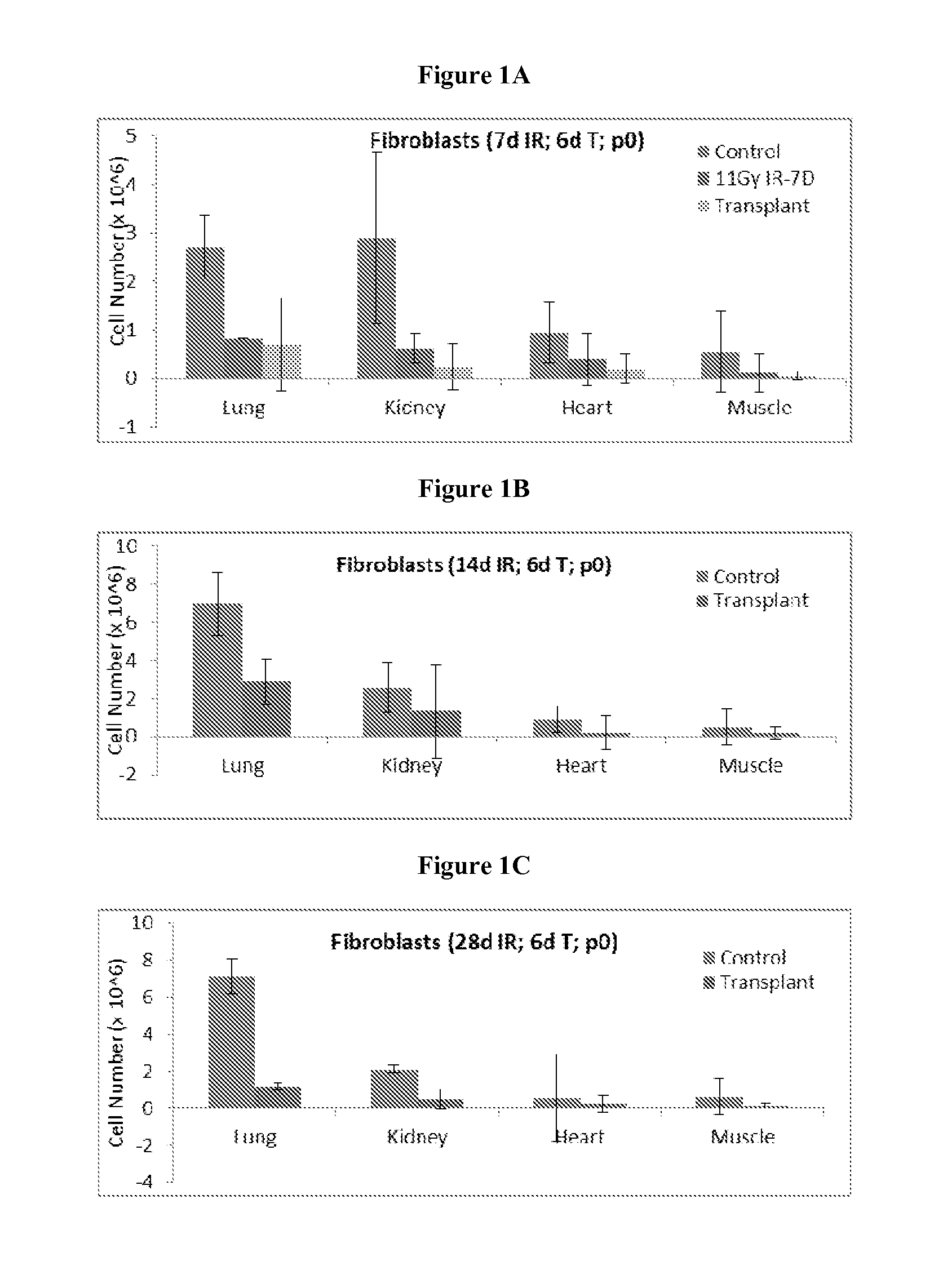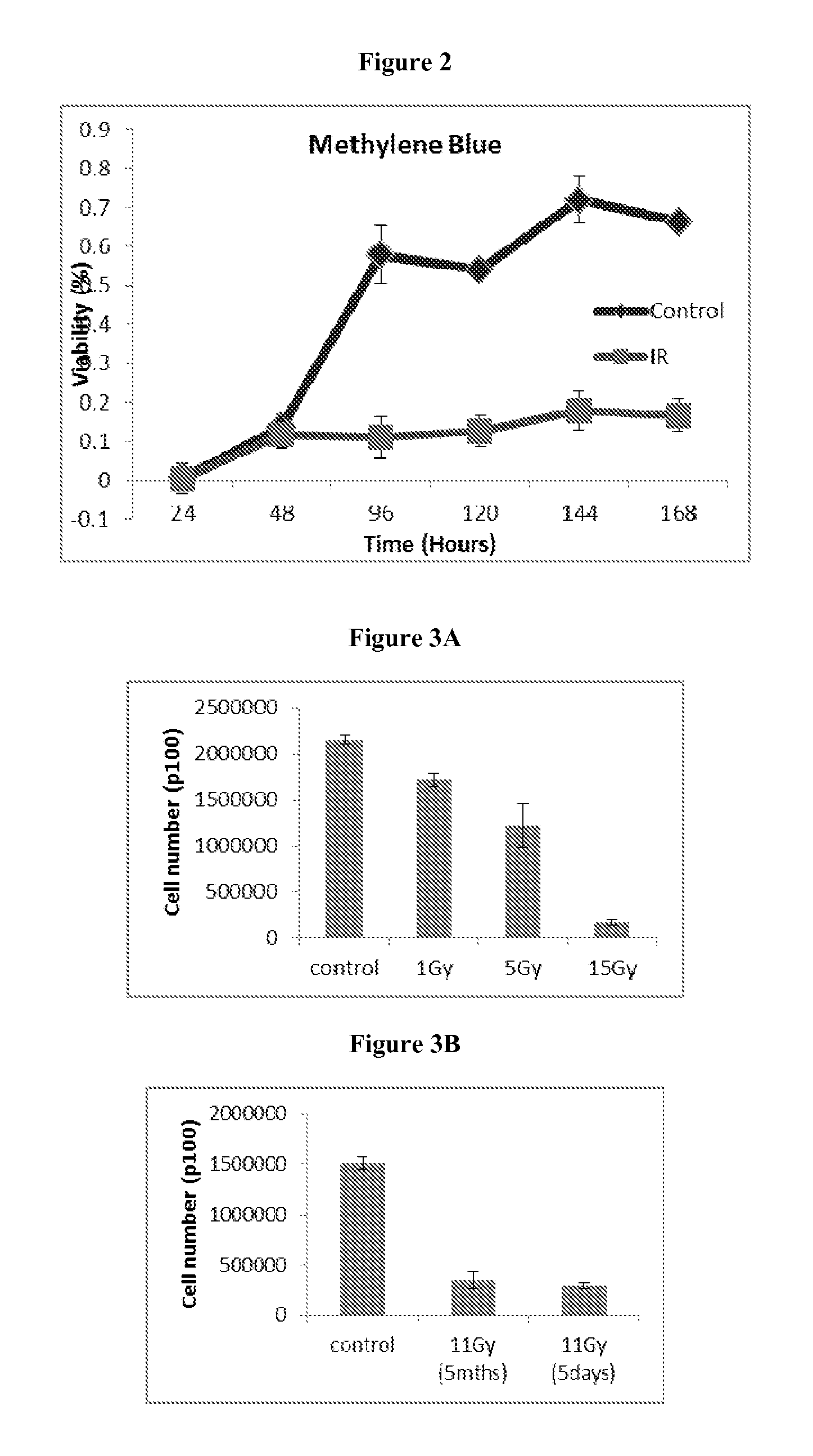Compositions and methods related to dormant senescence-prone cells (DSPC)
a technology of dormant senescence and prone cells, applied in the field of aging, can solve the problems of requiring emergency physiological responses, dna damage, and no objective biological assay enabling one to estimate the biological age of the organism, and achieve the effect of avoiding weight gain and reducing the amoun
- Summary
- Abstract
- Description
- Claims
- Application Information
AI Technical Summary
Benefits of technology
Problems solved by technology
Method used
Image
Examples
example 1
[0064]This Example demonstrates that mesenchymal cells isolated from irradiation treated mice fail to proliferate in culture, and that this effect can be detected weeks after radiation. In this regard, FIGS. 1A-1C summarize in bar graphs data obtained from analysis of mouse mesenchymal cells isolated from 11Gy total body irradiated in vivo C57Bl / 6 mice from various tissues (lung, kidney, heart and muscle). The cells were isolated using 2 mg / ml of Dispase II (Roche) for 90 min digestion. Cells derived from untreated animals when placed in vitro proceeded to proliferate, whereas cells isolated from irradiation treated animals ceased proliferation when placed in culture. Moreover, the same effect was observed when the cells were isolated and placed in culture at various time points after radiation treatment at 7 (FIG. 1A), 14 (FIG. 1B) and 28 (FIG. 1C) days. Bone marrow transplantation was used to rescue the mice from lethal 11Gy irradiation. Mesenchymal cells isolated from irradiation...
example 2
[0065]This Example demonstrates the effects on cell proliferation induced by radiation. In this regard, as shown in FIG. 2, to compare the doubling capacity of lung mesenchymal cells isolated from radiation treated and untreated mice, the viability was assayed by methylene blue at various time points after plating. One thousand cells were plated per well in 96 well-plate in triplicate; cells were fixed and stained using methylene blue. The experiment lasted 168 hours and we determined that cells isolated from untreated animals continue proliferation, whereas cells isolated from radiation treated animals do not.
example 3
[0066]This Example provides an analysis of the influence of time elapsed after radiation, versus the effect of just the dosage of radiation itself. The results are presented in FIGS. 3A-3B. To determine whether it is the time after radiation or whether the dose of the radiation is critical for the termination of cell division, lung mesenchymal cells were isolated 72 hours following either 0, 1, 5 or 15Gy of radiation (FIG. 3A) or cells were isolated after 11Gy of TBI after 5 days or 5 months (FIG. 3B). The experiment showed that the dose of the radiation is more critical than the length of time passed after the IR-treatment.
PUM
| Property | Measurement | Unit |
|---|---|---|
| time | aaaaa | aaaaa |
| time | aaaaa | aaaaa |
| time period | aaaaa | aaaaa |
Abstract
Description
Claims
Application Information
 Login to View More
Login to View More - R&D
- Intellectual Property
- Life Sciences
- Materials
- Tech Scout
- Unparalleled Data Quality
- Higher Quality Content
- 60% Fewer Hallucinations
Browse by: Latest US Patents, China's latest patents, Technical Efficacy Thesaurus, Application Domain, Technology Topic, Popular Technical Reports.
© 2025 PatSnap. All rights reserved.Legal|Privacy policy|Modern Slavery Act Transparency Statement|Sitemap|About US| Contact US: help@patsnap.com



